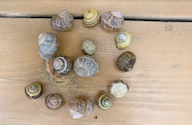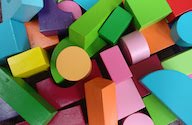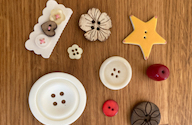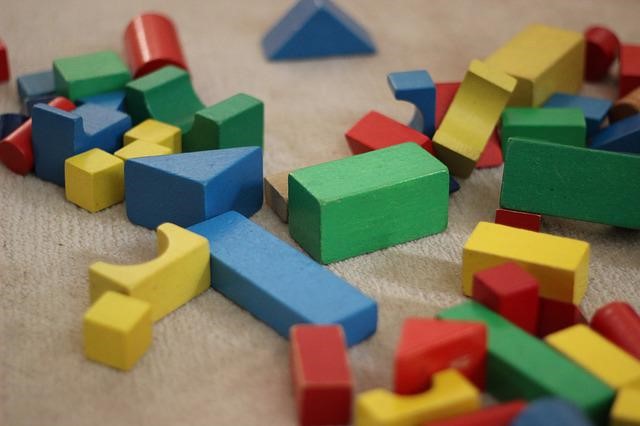Skip over navigation





 Resources
Resources
All the blocks, both hollow and solid, that you can find, including regular and irregular shapes.
Or search by topic
Number and algebra
Geometry and measure
Probability and statistics
Working mathematically
Advanced mathematics
For younger learners
Building Towers
Age 3 to 5
Exploring 3D shapes





Children often enjoy playing with blocks.
Adults could encourage children who show an interest in building towers to explore further, in order to develop an awareness of the properties of 3D shapes.
The Activity
Provide children with a selection of wooden blocks of various shapes. Talk about experiences of building and stacking. (Children may do all sorts of things with blocks, building towers is just one example you might choose to develop mathematically.)
Provide children with a selection of wooden blocks of various shapes. Talk about experiences of building and stacking. (Children may do all sorts of things with blocks, building towers is just one example you might choose to develop mathematically.)
Encouraging mathematical thinking and reasoning:
Describing
Which block are you going to put on top of your tower?
Which is the tallest block in your tower?
Which block are you going to put on top of your tower?
Which is the tallest block in your tower?
Reasoning
How could you make your tower taller?
I wonder if we could stack two shapes like this on top of each other?
Which blocks would you use to make a very big castle?
What would happen if we turned that block the other way up, would it make the tower any different?
If you do that, will it fall down? Can you do that without it falling down?
How could you make your tower taller?
I wonder if we could stack two shapes like this on top of each other?
Which blocks would you use to make a very big castle?
What would happen if we turned that block the other way up, would it make the tower any different?
If you do that, will it fall down? Can you do that without it falling down?
Opening Out
Encourage children to feel the surfaces of the blocks, finding and selecting flat surfaces on which to stand the blocks.
Can you balance this flat block on these three cones? What if they're in a straight line? What if you squash them together?
Could you build with only cylinders?
Encourage children to feel the surfaces of the blocks, finding and selecting flat surfaces on which to stand the blocks.
Can you balance this flat block on these three cones? What if they're in a straight line? What if you squash them together?
Could you build with only cylinders?
Recording
Let's make a picture of your tower.
You could print a picture with blocks dipped in paint.
Let's make a picture of your tower.
You could print a picture with blocks dipped in paint.
The Mathematical Journey
Properties of shapes:
- selecting appropriate blocks to represent something else or to fit into a structure, analysing properties such as flat, curved etc.
- using informal language - soft, smooth, sharp, slopey, pointy, like a brick, arch, box, roof etc.
- using mathematical language - corner, side, flat, curved, rectangular, cylinder etc.
Position and spatial properties:
- positional language - on top of, next to, underneath, in front of, behind, between, left, right etc.
- using symmetry for placing blocks, creating patterns and complex structures e.g. castles
- connecting ideas about balance to the choice of blocks
Development and Variation
Other activities that complement this:
Story, rhyme and song links
London Bridge is Falling Down
Humpty Dumpty
Build a House with Five Bricks
Titch by Pat Hutchins
Rapunzel and Jack and the Beanstalk (traditional tales)
How Big is a Pig? by Clare Beaton
All Shapes and Sizes by Shirley Hughes
Other activities that complement this:
- Stacking box-modelling materials and other containers
- Stacking shoe boxes in a role-play shoe shop
- Stacking cuboid boxes or cylinders as tins in a role play grocery shop
- Making large-scale constructions using crates, large boxes and cylinders
- Stacking stones or sticks in a forest school environment
- Making a pile of real bricks
- Tackling group challenges such as building a castle for a mouse, a house for a teddy or a giant's castle
Story, rhyme and song links
London Bridge is Falling Down
Humpty Dumpty
Build a House with Five Bricks
Titch by Pat Hutchins
Rapunzel and Jack and the Beanstalk (traditional tales)
How Big is a Pig? by Clare Beaton
All Shapes and Sizes by Shirley Hughes
 Resources
Resources All the blocks, both hollow and solid, that you can find, including regular and irregular shapes.
Download a PDF of this resource.


